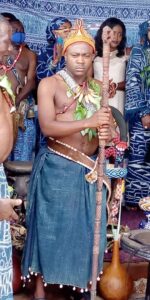There is a new dawn in Bamendankwe, Bamenda I sub division, Mezam division of the North West region as a new and youthful Fon, HRH Fon Forchesiri III, has been crowned.
He was officially presented to the Bamendankwe people and the general public at the esplanade of the Fon’s palace during a highly traditional occasion on Wednesday September 3.
The traditional ceremony was witnessed by the Senior Divisional Officer for Mezam, Simon Emile Mooh, among other administrative, traditional and municipal authorities.
Meanwhile, on Thursday September 4, the new traditional ruler was also presented to the governor of the North West region.
This was during highly significant event in the governor’s office.
Fon Forchesiri III takes over from his father, Fon Forsuh Nforngwa II, who had ruled the village for over three decades.
Fon Forchesiri III is the 26th Fon of Bamendankwe.
The public presentation of the new Fon was marked by the display of the customs and traditions of the Bamendankwe people.
The people of the village came en mass from far and near.
The event, which began as early as 6 a.m., first witnessed the announcement of the ‘disappearance’ of the previous Fon.
The villagers turned out dressed without tops, raffia fibres adorning their dresses and wood ash splashed on their bodies.
The high point of the event was when the new Fon was brought out to the arena to be symbolically ‘stoned’ before being taken back into the inner chambers of the palace.
This, according to the customs and tradition of the Bamendankwe people, is symbolic in that it empowers the Fon and indicates that the entire population of Bamendankwe has given him absolute power and authority over the village.
It also means henceforth the Fon would have to be respected without question and becomes the custodian of the Bamendankwe tradition and the link between his subjects and their ancestors.
After the first phase of the occasion, the villagers then went to nearby streams to wash off the wood ash from their bodies and head back to the palace for another phase.
Fon Forchesiri III, who was named Amah George Nforgwa at birth, holds a BA in Banking and Finance.
He is currently a student at the Advanced School of Administration and Magistracy, ENAM.

Speaking to News Upfront after the event, the president of Bamendankwe Cultural and Development Association, BAMEDCA, Tantoh Emmanuel, said:
“It has been a very successful event. We started here in the morning and we saw men and women come almost naked.
Men were putting on their shorts and the women were completely if not half naked.
This has come to show that the culture of the Bamendankwe man is still alive and with the coming of our new Fon you can see that there is total happiness and unity amongst the Bamendankwe people”.
“The turnout was so wonderful. As the BAMEDCA president, I am so impressed. Looking at the turnout, I believe that the development of these people is going to follow, from the way things are beginning to change. In a nutshell I think we have better days ahead,” he added.
“I want to encourage and call on my brothers and sisters that let’s together join hands and give our new Fon the respect that he deserves so that together we can build a wonderful Fondom. I pray that the Lord Almighty will grant our new Fon, HRH Forchesiri III, the wisdom that he deserves in order to accomplish the great mission that has been assigned to him by his village. I think everybody leaving here, from the SDO is happy and everybody who was here has witnessed a wonderful occasion,” Tantoh states.
Bamendankwe, it should be noted, is bordered to the North by Awing and Santa; South West by Nkwen; West by Bambili, Babanki Tungoh, Balikumbat and Banjah; South East by Akum.
The village is headed by a Fon. It has 36 quarters headed by quarter heads. These quarter heads and a traditional council assist the Fon in administering the village.
Bamendankwe is the village that hosted the administrative headquarters of the former Bamenda division and currently hosts that of the North West region.
In this regard, the importance of Bamendankwe dates back from the time of the German administration of the Western Grassland plateau in the year 1902.








